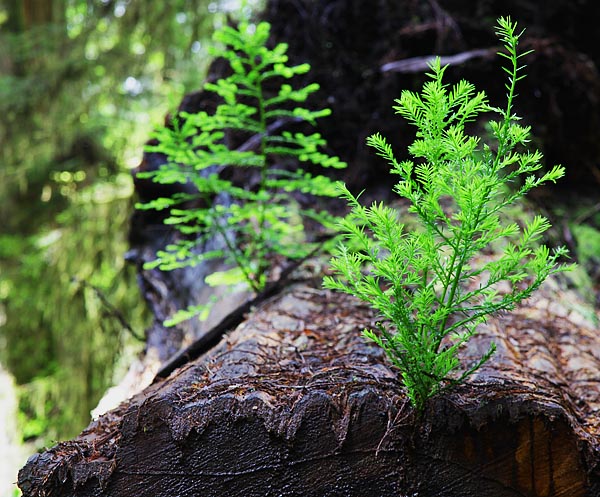What is the truth about fog and coast redwoods? What is the role of fog in those forests, and is everything we read and hear about it true? How about if we start with the myth that coast redwoods need fog to survive.
Coast redwood’s natural range is near the coast, but they are planted in many other areas that have much less rain and fog. Have you driven through Seattle Washington? Or Portland, Ashland and Grants Pass in Oregon? Those cities have plenty of coast redwoods planted in various parks, plant collections and residential properties. Unlike coastal rainfall like 80 inches per year in Jedediah Smith redwood park, those urban redwoods see just 19 inches to 36 inches per year and much less fog. So why are they still alive if fog is essential for coast redwood survival? The truth is that fog is not essential for survival, nor 60 – 100 inches of yearly rainfall.
I think the role of fog for indigenous coast redwood forests may reside with germination and replenishment of seedlings.
Although redwoods can grow without fog and a lot of rain it’s more or less indisputable that coast redwoods will attain exceeding great volume and height where fog and rain are abundant. I think Sequoiadendron can possibly reach titan dimensions outside its natural range, but I don’t think coast redwood can do it.
This all came to mind again August, 2016, after chasing-down a report of coast redwoods near Red Buttes Wilderness, southwest of Jacksonville, Oregon, the historic gold mining town. When I got to the reported forest area, I found misidentified Yew trees growing beneath Douglas firs that were 4 ft. to 6 ft. diameter. Although we found no coast redwoods, I realized right away that coast redwoods could easily survive in that part of Red Buttes Wilderness. The elevation was about 2700 ft., just a few hundred feet higher than Bald Hills Rd. in Redwood National Park. And even though summer was on the decline there was ample moisture and springs were still flowing. The tops of big boulders around the primary creek were still damp at 10 am.
When we left the area, I kept asking myself why is it that coast redwoods are not growing there, but grow at the coast (regardless of size). Why is it that they germinate at the coast and cover thousands of acres, but not in this place?
I suspect that the role of fog and much rain may have more to do with germination of seeds and survival of seedlings.
Coast redwood seeds are not highly viable. From very young coast redwoods, maybe 1% of seeds germinate. Up to 5% may germinate from trees over 300 yrs. old. Few survive due to parasitic fungi, drought and other factors. But either way, they need plenty of moisture after germination.
I don’t believe that individual established redwoods rely on fog to survive. But a forest of the species can use the fog and abundant rain to aid seedlings after germinating.
In all my years of arborist tree care in Washington, Oregon and California, I do not recall finding a single coast redwood seedling germinated in any landscape or park outside areas like Del Norte, Humboldt, Mendocino, etc.. I have found Japanese maple seedlings, by the thousands. I’ve seen Douglas fir, western hemlock, vine maple, etc.. Likewise Deodar cedar. Those all germinate around the Pacific NW, and several in the coast redwood old growth forests.
On the other hand, I rarely see coast redwood seedlings even in their natural range, but there are some. Much of the natural propagation seems to come from sprouts off roots and stumps, etc..
Fog also drips off branches and irrigates the forest floor. That may also be part of the natural irrigation plan that enables coast redwoods to reproduce and grow along the edge of the west coast, but nowhere else.
More information about coast redwood’s durability is included at another page. They can take heat to 115 degrees F and rainfall as low as 20 inches yearly: https://mdvaden.com/redwood_fog_climate.shtml


Recent Comments